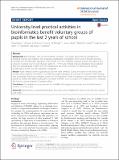Files in this item
University-level practical activities in bioinformatics benefit voluntary groups of pupils in the last 2 years of school
Item metadata
| dc.contributor.author | Barker, Daniel | |
| dc.contributor.author | Alderson, Rosanna Grace | |
| dc.contributor.author | McDonagh, James L. | |
| dc.contributor.author | Plaisier, Heleen | |
| dc.contributor.author | Comrie, Muriel Margaret | |
| dc.contributor.author | Duncan, Leigh | |
| dc.contributor.author | Muirhead, Gavin T.P. | |
| dc.contributor.author | Sweeney, Stuart D. | |
| dc.date.accessioned | 2015-10-28T11:09:59Z | |
| dc.date.available | 2015-10-28T11:09:59Z | |
| dc.date.issued | 2015-10-28 | |
| dc.identifier | 223321164 | |
| dc.identifier | cd6b6777-05e1-4d05-8985-75494f870369 | |
| dc.identifier | 84959501857 | |
| dc.identifier | 000442749600017 | |
| dc.identifier.citation | Barker , D , Alderson , R G , McDonagh , J L , Plaisier , H , Comrie , M M , Duncan , L , Muirhead , G T P & Sweeney , S D 2015 , ' University-level practical activities in bioinformatics benefit voluntary groups of pupils in the last 2 years of school ' , International Journal of STEM Education , vol. 2 , 17 . https://doi.org/10.1186/s40594-015-0030-z | en |
| dc.identifier.uri | https://hdl.handle.net/10023/7704 | |
| dc.description | This work was supported in part by the Science and Technology Facilities Council under grant ST/M000435/1 to Daniel Barker. | en |
| dc.description.abstract | Background Bioinformatics—the use of computers in biology—is of major and increasing importance to biological sciences and medicine. We conducted a preliminary investigation of the value of bringing practical, university-level bioinformatics education to the school level. We conducted voluntary activities for pupils at two schools in Scotland (years S5 and S6; pupils aged 15–17). We used material originally developed for an optional final-year undergraduate module and now incorporated into 4273π, a resource for teaching and learning bioinformatics on the low-cost Raspberry Pi computer. Results Pupils’ feedback forms suggested our activities were beneficial. During the course of the activity, they provide strong evidence of increase in the following: pupils’ perception of the value of computers within biology; their knowledge of the Linux operating system and the Raspberry Pi; their willingness to use computers rather than phones or tablets; their ability to program a computer and their ability to analyse DNA sequences with a computer. We found no strong evidence of negative effects. Conclusions Our preliminary study supports the feasibility of bringing university-level, practical bioinformatics activities to school pupils. | |
| dc.format.extent | 8 | |
| dc.format.extent | 601266 | |
| dc.language.iso | eng | |
| dc.relation.ispartof | International Journal of STEM Education | en |
| dc.subject | Bioinformatics | en |
| dc.subject | Computational biology | en |
| dc.subject | Secondary school | en |
| dc.subject | Raspberry Pi | en |
| dc.subject | Open access teaching material | en |
| dc.subject | Case study | en |
| dc.subject | QH301 Biology | en |
| dc.subject.lcc | QH301 | en |
| dc.title | University-level practical activities in bioinformatics benefit voluntary groups of pupils in the last 2 years of school | en |
| dc.type | Journal article | en |
| dc.contributor.sponsor | Science & Technology Facilities Council | en |
| dc.contributor.institution | University of St Andrews. School of Biology | en |
| dc.contributor.institution | University of St Andrews. School of Chemistry | en |
| dc.identifier.doi | 10.1186/s40594-015-0030-z | |
| dc.description.status | Peer reviewed | en |
| dc.identifier.grantnumber | ST/M000435/1 | en |
This item appears in the following Collection(s)
Items in the St Andrews Research Repository are protected by copyright, with all rights reserved, unless otherwise indicated.

